India is silently reinforcing its strategic posture with the Shaurya hypersonic missile, a homegrown weapon system that combines blistering speed, stealthy deployment, and nuclear readiness. Unlike conventional ballistic platforms, Shaurya is designed for rapid mobility and operational flexibility, making it a favourite among military strategists and defence analysts.
If you’re a defence enthusiast or geopolitics observer, this is the missile that defines India’s 21st-century deterrence.
What is the Shaurya Hypersonic Missile? DRDO’s Hypersonic Ballistic Weapon Explained
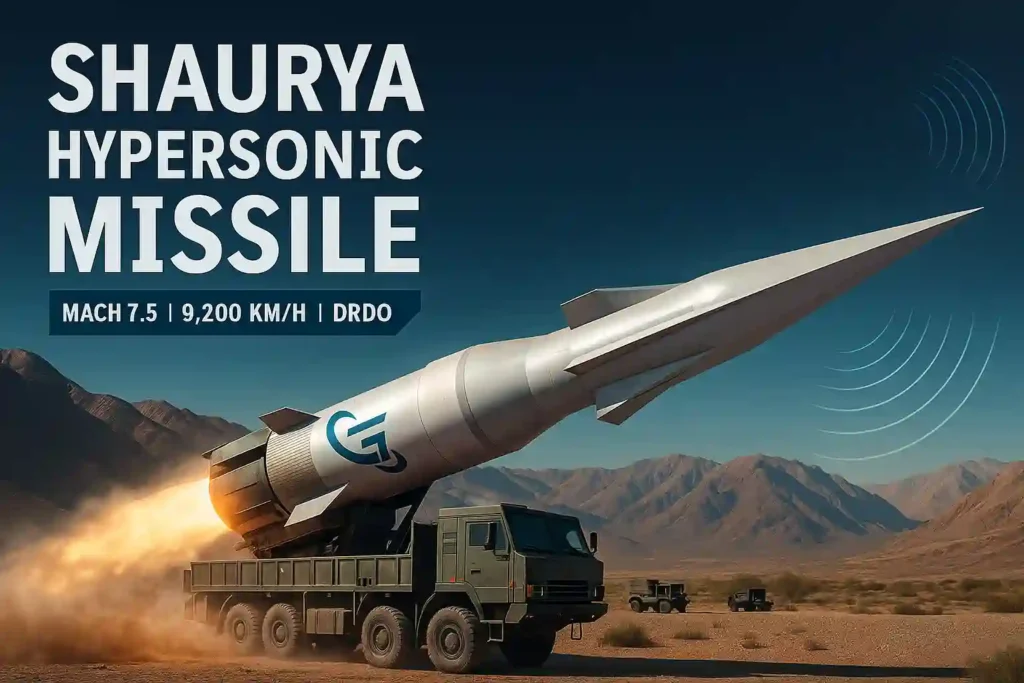
The Shaurya missile is a two-stage, solid-fuel, surface-to-surface ballistic missile developed by DRDO. But what sets it apart is its hypersonic speed, reaching up to Mach 7.5 (~9,200 km/h), coupled with its canister-based cold launch system.
This tactical nuclear-capable missile features a quasi-ballistic flight path, which allows it to manoeuvre during the terminal phase, making it difficult for enemy air defences to intercept. Such manoeuvrability makes Shaurya a nightmare for radar systems.
Shaurya Missile Range in KM: Reach, Coverage & Theatre-Level Advantage
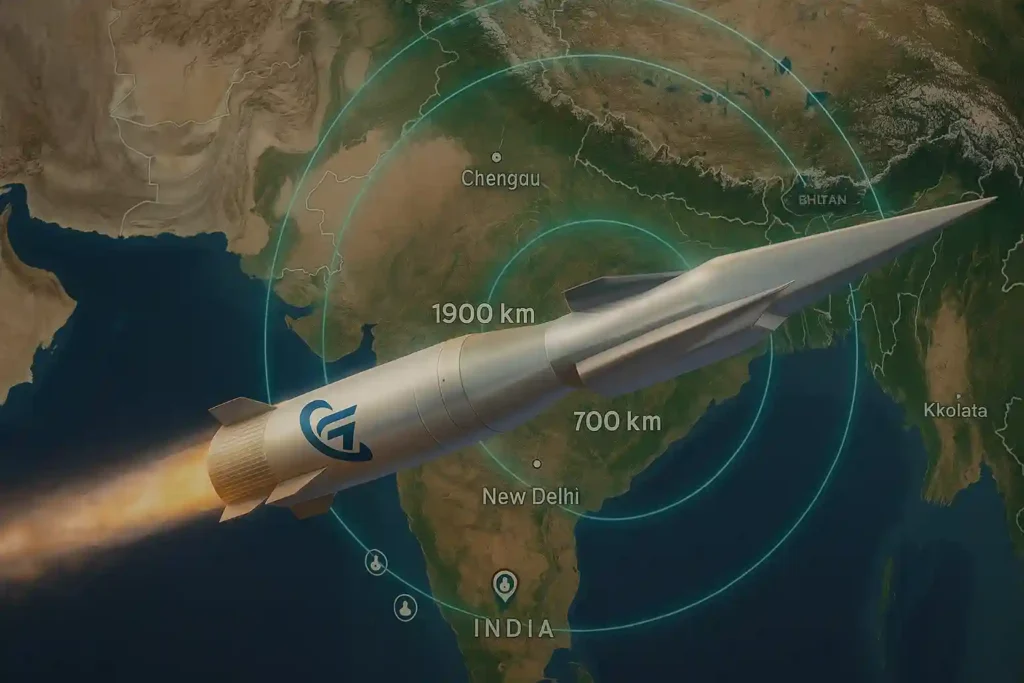
The Shaurya hypersonic missile range officially lies between 700 km to 800 km, which places it well within the category of short-to-intermediate range ballistic missiles. However, various defence sources, including internal assessments cited on DefenceNewsIndia.in, suggest that Shaurya can reach up to 1,900 km when launched at a depressed trajectory.
Such a range gives it the ability to strike key installations in adversarial territories without leaving Indian airspace.
Shaurya Missile Speed and Flight Path: How Fast is India’s Hypersonic Ballistic Missile?
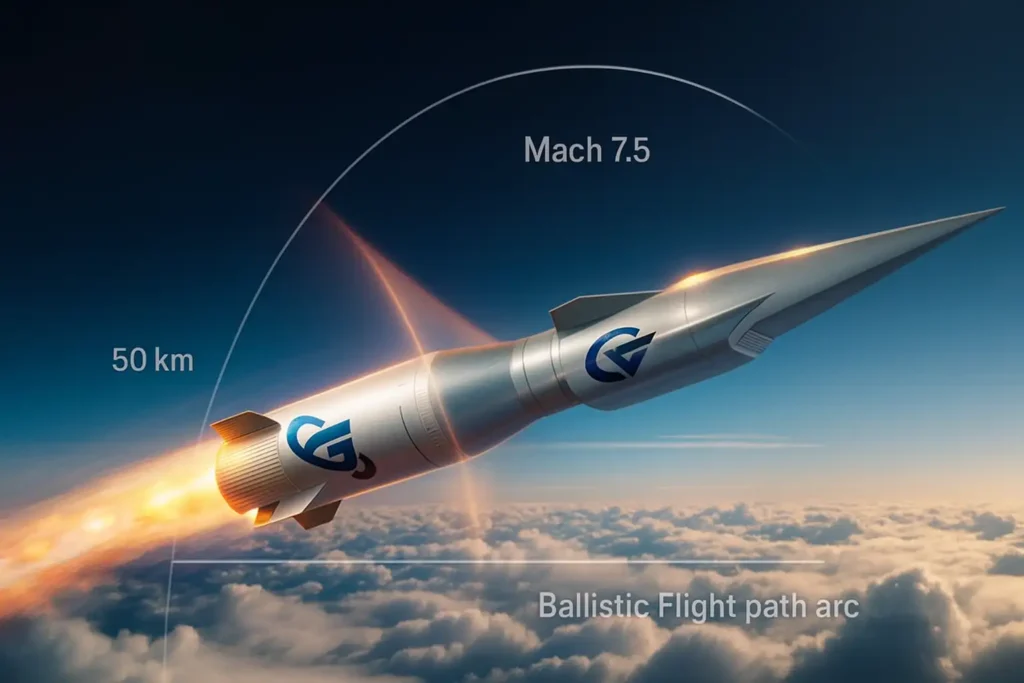
Many people confuse it with a cruise missile due to its low trajectory and terminal agility. However, Shaurya is a ballistic missile, albeit with a hypersonic twist. It doesn’t cruise at low altitudes like the BrahMos; instead, it achieves high speed and arcs before descending with deadly accuracy.
This blend of ballistic dynamics with cruise-like agility is what makes Shaurya a unique hybrid missile.
Shaurya Missile: Cruise or Ballistic? The Strategic Difference
Equipped with ring laser gyroscopes and advanced inertial navigation systems, Shaurya maintains a CEP (Circular Error Probable) of just 20–30 metres. This level of precision ensures that even hardened bunkers or high-value targets can be neutralised.
It can carry both nuclear and conventional payloads, weighing between 200 kg to 1,000 kg, offering flexibility in tactical as well as strategic missions.
Shaurya Missile Warhead & Guidance System Explained
Shaurya’s canisterised cold launch system gives it unmatched battlefield survivability. This system allows the missile to be stored and launched from road-mobile Transporter Erector Launchers (TELs). Its key advantages include:
- Quick-launch readiness with minimal setup
- Lower thermal and radar signature
- High survivability during first-strike scenarios
This makes Shaurya a perfect second-strike asset in India’s nuclear doctrine.
What is the Cost of Shaurya Hypersonic Missile? Budget & Defence Value
As per estimates featured on DefenceNewsIndia.in, the Shaurya missile cost ranges between ₹75 to ₹100 crore per unit. While not cheap, it is far more affordable than importing systems with similar capabilities. Moreover, it’s fully indigenous, contributing to India’s defence autonomy under Atmanirbhar Bharat.
Canister-Launched Hypersonic Missile: Shaurya’s Mobile Strike Advantage
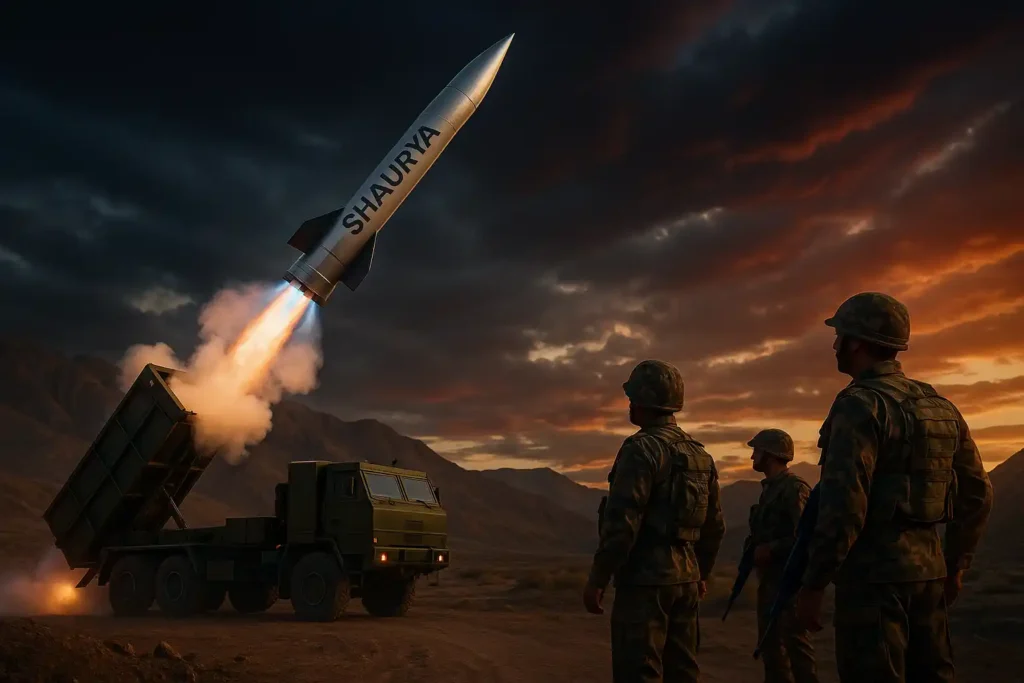
Shaurya’s canisterised cold launch system enables quick, concealed and mobile operations across terrains. The mobility provided by road-mobile launchers ensures:
- Reduced pre-launch exposure
- Rapid redeployment
- Enhanced survivability under nuclear doctrine
Shaurya Missile DRDO Development Timeline: From Test to Deployment
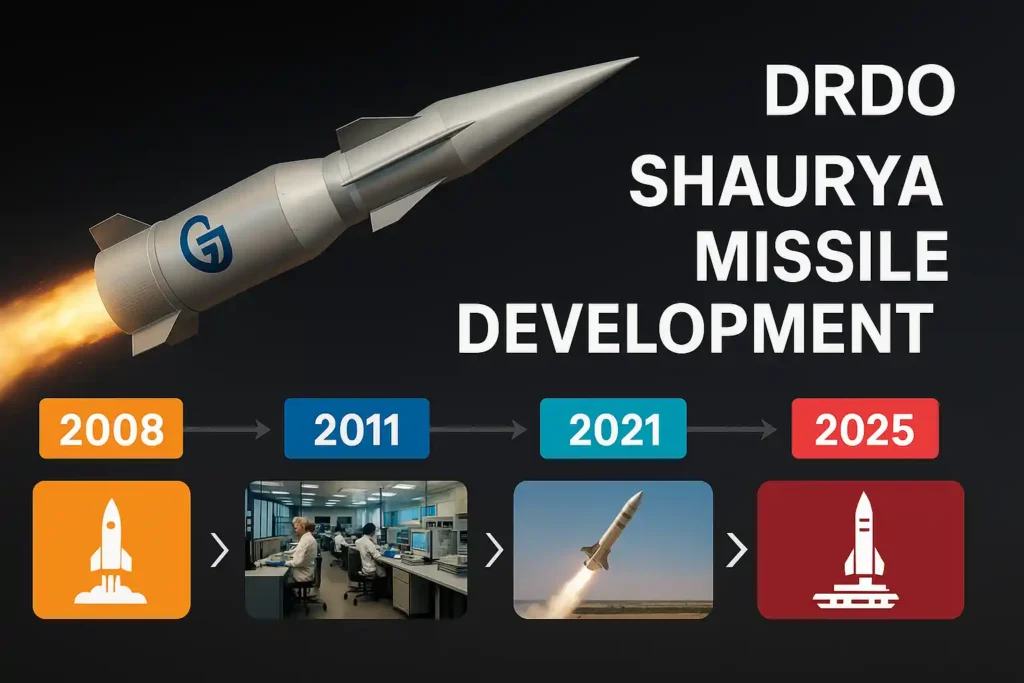
The missile’s development under DRDO was part of a broader classified programme aligned with the Advanced Technology Vehicle (ATV) initiative.
Key Milestones
- 2008: First successful launch from Chandipur
- 2011: Achieved Mach 7.5 and validated full configuration
- 2020: Final user trials by Strategic Forces Command (SFC)
- 2025: Fully operational and deployed across strategic sectors
Shaurya Missile’s Role in India’s Nuclear Doctrine & Second-Strike Capability
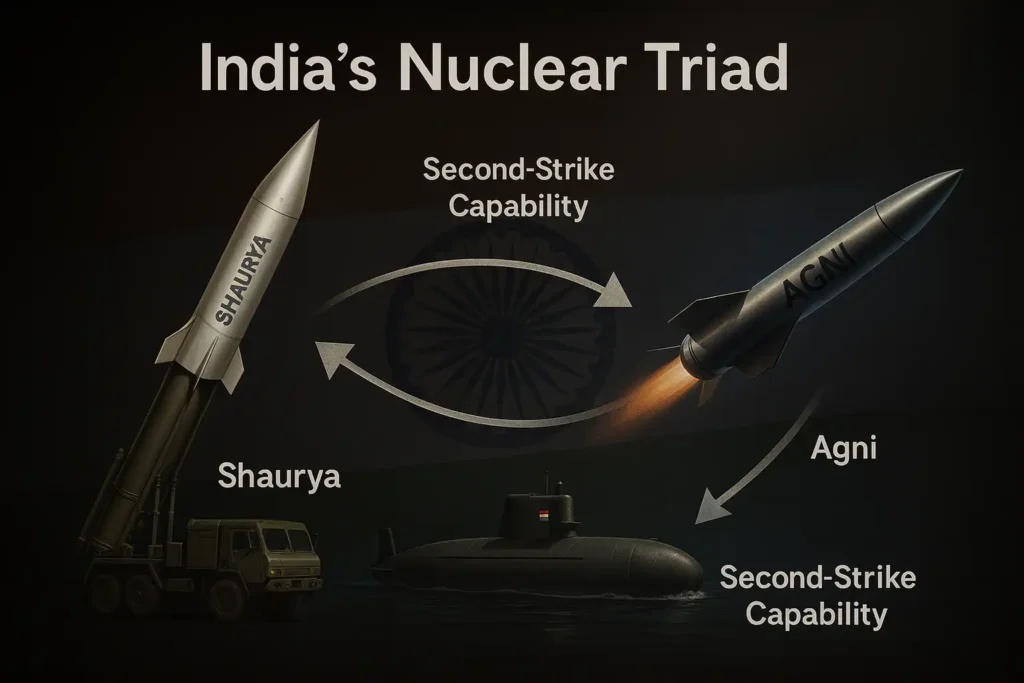
India follows a strict No First Use (NFU) nuclear policy. Therefore, survivable delivery systems are crucial. Shaurya fulfills this with its:
- Road mobility and hidden deployment options
- High speed to evade interceptors
- Canisterisation for prolonged storage
It complements sea-based systems like INS Arihant and land-based long-range Agni series missiles, making it a cornerstone of the second-strike capability.
Shaurya Missile vs BrahMos 2: Hypersonic Comparison for Indian Defence
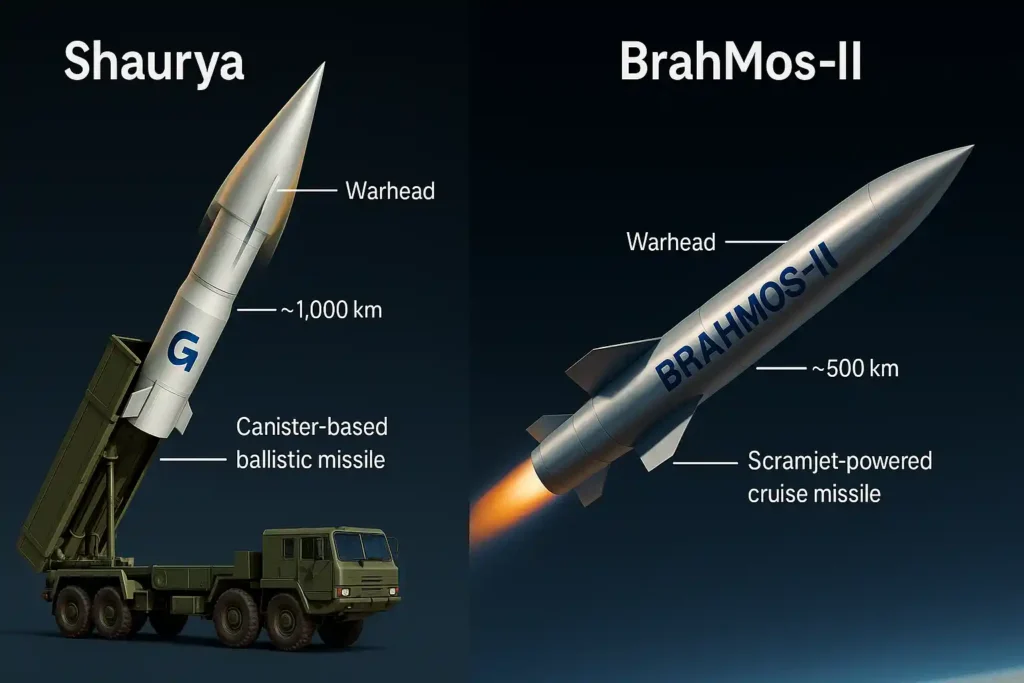
While both are hypersonic, the purpose and design of Shaurya vs BrahMos-II differ significantly:
Shaurya:
- Hypersonic ballistic missile
- Nuclear and conventional warhead capable
- Range: 700–1,900 km
- Deployed under Strategic Forces Command
BrahMos-II:
- Hypersonic cruise missile (under development)
- Primarily conventional warhead
- Projected range: ~800 km
- Tactical theatre-level strike weapon
Together, they complete India’s hypersonic missile portfolio.
FAQs on Shaurya Hypersonic Missile: Range, Type, Speed, Cost
1. Is Shaurya missile the fastest in India?
Yes. With speeds reaching Mach 7.5, it is among the fastest operational Indian missiles.
2. What is the Shaurya hypersonic missile range?
Officially 700–800 km, but it may reach up to 1,900 km depending on the trajectory.
3. Is Shaurya a cruise or ballistic missile?
Ballistic. It features hypersonic speed and terminal manoeuvrability but follows a ballistic profile.
4. What is the cost of Shaurya missile?
Estimated between ₹75 to ₹100 crore per unit.
5. What is the name of India’s hypersonic missile?
Shaurya is operational. Other projects like BrahMos-II and HSTDV are under development.
6. Who developed Shaurya missile?
It was developed by DRDO, with full indigenous capabilities.
7. Where is the Shaurya missile deployed?
Under the control of Strategic Forces Command, deployed in high-priority sectors across northern and eastern India.
Shaurya Hypersonic Missile Summary: Why It Matters in 2025 & Beyond
In a geopolitical landscape defined by fast, invisible threats, the Shaurya hypersonic missile is India’s definitive answer to future warfare. With strategic mobility, hypersonic strike speed, and credible nuclear payload delivery, Shaurya is not just a missile—it’s a message.
For defence enthusiasts, this missile marks India’s maturity in mastering next-generation hypersonic weaponry. For the region, it reinforces the doctrine of credible minimum deterrence
